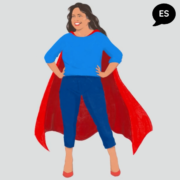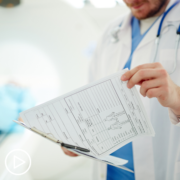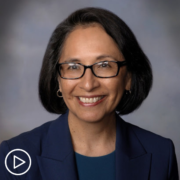Yolanda’s Story: My Path to a Myeloproliferative Neoplasm Diagnosis
Yolanda’s Story: My Path to a Myeloproliferative Neoplasm Diagnosis from Patient Empowerment Network on Vimeo.
Latina essential thrombocythemia (ET) patient Yolanda had many symptoms before receiving her ultimate diagnosis. Watch as she shares the symptoms she experienced, her long path to diagnosis, and her lessons learned about patient empowerment.
Related Resources:

|

La historia de Yolanda: mi camino hacia un diagnóstico de neoplasia mieloproliferativa |

|
Transcript:
My name is Yolanda, and I was diagnosed in my mid-40s with essential thrombocythemia (ET), a myeloproliferative neoplasm. I’m a Latina woman, and my path to diagnosis took an extended time.
Thinking back on my journey, my symptoms began with severe headaches and dizziness that made it too difficult to finish my work. I also experienced debilitating fatigue that would either keep me in bed for a day, or I’d feel like my vision and thinking were in a fog. It all felt very strange, and I saw my doctor about the symptoms, but he prescribed antibiotics for an infection. Then later I felt numbness and tingling in my hands and feet and then pain in my abdomen. Finally, my doctor decided to run full blood work to see which levels might be abnormal, and that was followed with a bone marrow biopsy to further investigate.
When I finally received my diagnosis with essential thrombocythemia, I felt some relief but also a sinking feeling and dread of what might be ahead for me. I feel like one issue with getting diagnosed may have been that I looked healthy. Maybe my doctor would have ordered the blood work sooner if I didn’t look well. But I try to look forward rather than back. An MPN specialist was recommended to me, and he initially put me on low-dose aspirin.
Then I was prescribed hydroxyurea (Hydrea). I’ve been doing well and feel grateful to have treatment options. But if my disease progresses to a point where I need other options, I’ve already decided that I’ll consider participating in a clinical trial. I feel like I’ve been relatively lucky and want to share my cancer story to help others.
Some of the things I’ve learned on my MPN journey include:
- Empower yourself by asking your doctors questions about your MPN and what to expect before, during, and after treatment.
- Learn about clinical trial options. There may be programs that will help you with travel, lodging, and other uncovered expenses. And clinical trials may provide an option for your MPN if you’ve already used all other options.
- You are the person in charge of your health. If you feel like something is wrong in your body, advocate for yourself. Ask for more testing to find out what is wrong.
- Be careful about where you look for cancer information. Use credible sources like MPN Research Foundation, The Leukemia & Lymphoma Society, and Patient Empowerment Network.
These actions were key for staying on my path to empowerment.
Share Your Feedback
Create your own user feedback survey










